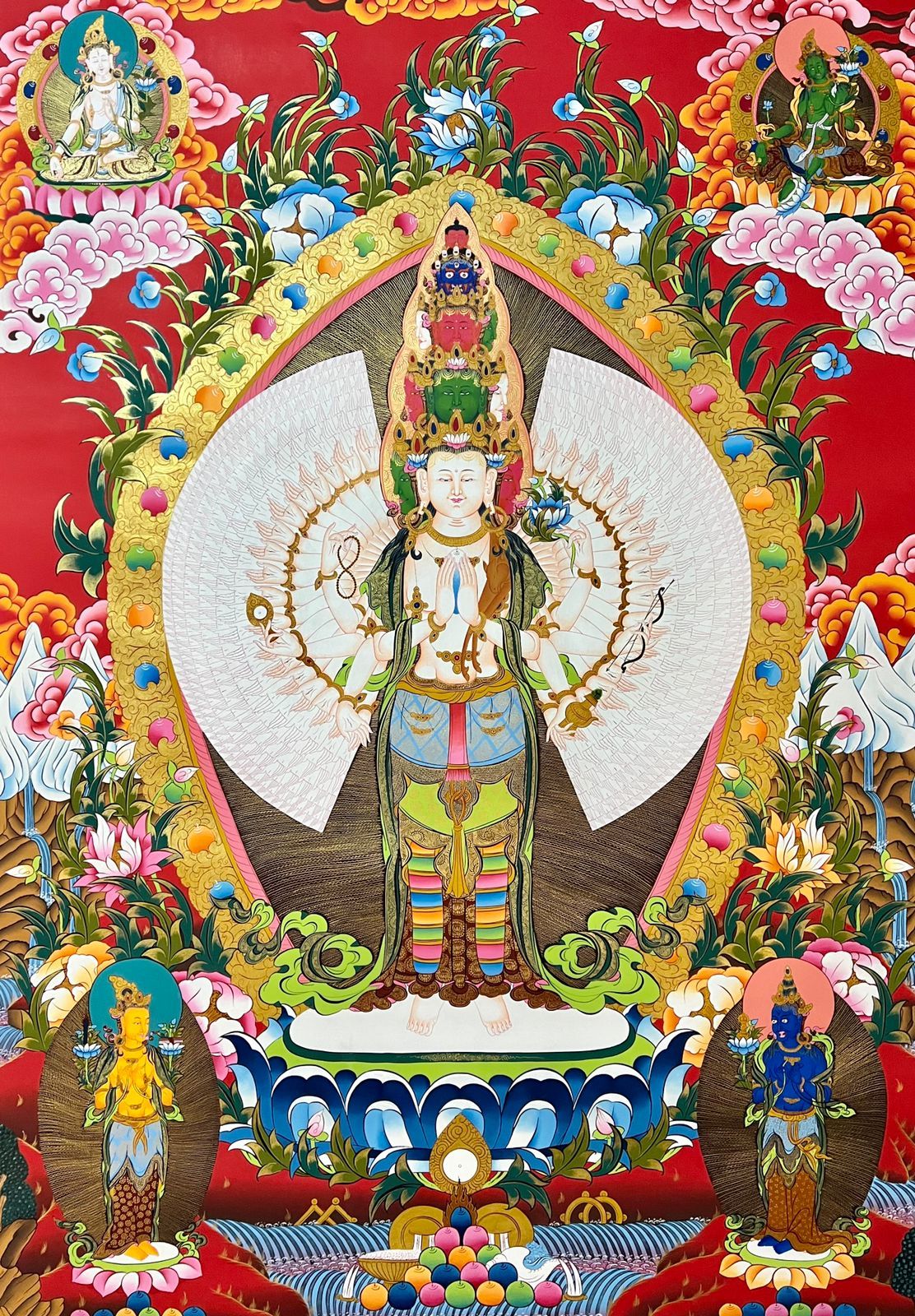

Lokeshvara with Amitabha Buddha Thangka
Lokeshvara with Amitabha Buddha thangka is handpainted on cotton canvas. The images of Amoghpasa can be found in Java, China, and Japan. Lokeshvara is a multi-armed form of Avalokiteshvara that seems to have been popular in Nepal since the Middle ages. The name suggests that he is the lord of the world with infallible noose which leads suffering sentient beings to enlightenment.
Lokeshvara presented at the center of the thangka. Manjushree is presented at the left down corner of the Lokeshvara in the thangka. Vajrapani is presented at the right down corner of the Lokeshvara in the thangka. Amitabha Buddha is presented at the top of the Lokeshvara in the thangka.
Iconography of Lokeshvara
Lokeshvara is the mystery in the center of the world lotus. All his limbs are white. He has one face and wears the saffron dress.
He is wearing an antelope skin symbolizing that he is extremely compassionate to suffering sentient beings. He has eight hands, the right showing the gesture of fearlessness and the boon granting gesture. He is holding the noose and the string of beads, the left holding a trident, a scripture, a white lotus, and a water pot.
Iconography of Manjushree
Manjushree is presented at the left down corner of the theLokeshvara in the thangka. Manjushree is the Bodhisattva who holds the flaming sword of enlightenment, by his left hand in a warning hand gesture in the left hand representing his realization of wisdom to cut through ignorance & wrong view. His right hand depicted in teaching holds the stem of a Blue Lotus flower upon which rests the Book (Pustaka) of Perfection of Transcendental Wisdom.
Mantra of Manjushree
The mantra of Manjushree is Om A Ra Pa Ca Na Dhih.
Iconography of Vajrapani
Vajrapani is presented at the right down corner of the Lokeshvara in the thangka. Vajrapaṇi is one of the earliest bodhisattvas of Mahayana Buddhism. He is the protector and guide of the Buddha and rose to symbolize the Buddha's power.
Vajrapani is pictured dancing wildly within a halo of flames which represents transformation.
He holds a vajra (thunderbolt) in his right hand which emphasizes the power to cut through the darkness of delusion. Vajrapani looks wrathful, but as a representation of the enlightened mind. He is completely free from hatred.
Mantra of Vajrapani
The mantra of Vajrapani is om vajrapani hum
Iconography of Amitabha buddha
Amitabha Buddha is presented at the top of the Lokeshvara in the thangka. Amitabha is head of the Lotus Family, one of the oldest & significant of the Five Buddha Families. This family represents love, purity, compassion & peace. Amitabha Purelandis a place of infinite bliss & boundless light.
Amitabha Buddha is also one of the five Tathagatas representing the wisdoAmitabha Buddha is also one of the five Tathagatas representing the wisdom of discriminating awareness. Amitabha Buddha is red in color. He is represented in the stupa facing to the west. He rides on a peacock symbolizing that he can take away the suffering of others just as the peacock eats poisonous plants and yet his tail shines forth.
Mantra of Amitabha Buddha
The mantra of Amitabha Buddha is Om ami dewa hr.











